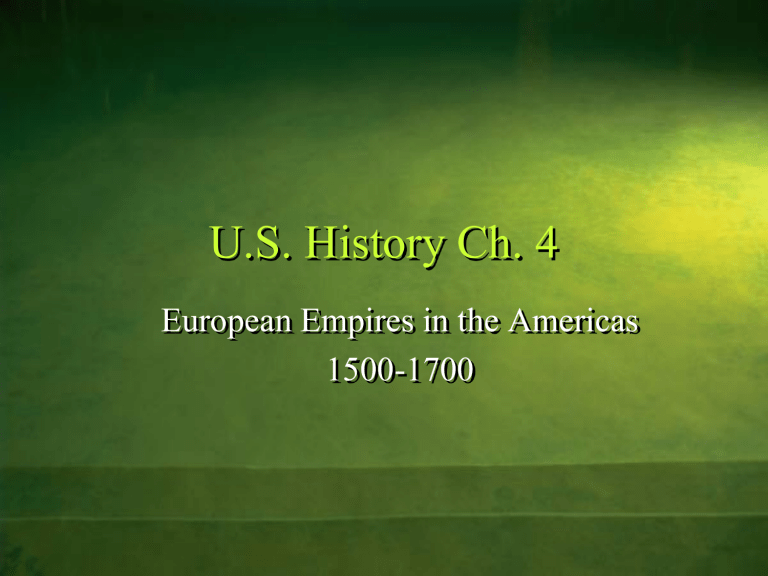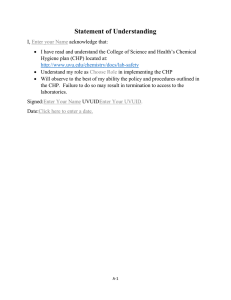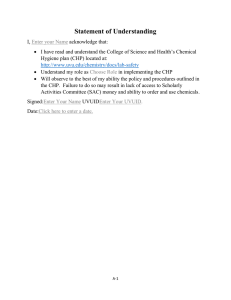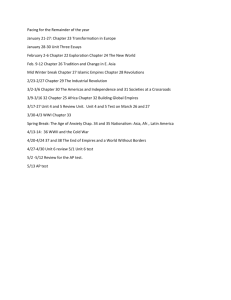U.S. History Ch. 4 European Empires in the Americas 1500-1700

U.S. History Ch. 4
European Empires in the Americas
1500-1700
Chp 4 (Early European Empires)
2
Hernan Cortes & the Aztec
• Spanish Governor asked Cortes to create a post on mainland
North America.
• March 1519, Cortes landed on the Yucatan Peninsula
• Met Malintzin who spoke both Nahuatl (Aztec language) and Mayan. She became Cortes’ interpreter.
• April, 1519, Cortes began marching inland toward
Tenochtitlan.
• Founded colony on the coast and named it Veracruz, claiming Mexico for Spain and the Roman Catholic Church.
• Burned his ships before leaving, to prevent his men from retreating to Cuba.
• Montezuma tried to stop Cortes by sending him bags of gold, but this just made him want more
Chp 4 (Early European Empires)
3
Chp 4 (Early European Empires)
Cortes
4
Chp 4 (Early European Empires)
5
Chp 4 (Early European Empires)
6
Chp 4 (Early European Empires)
7
Chp 4 (Early European Empires)
8
Cortes in Tenochtitlan
• Arrived at Tenochtitlan on November 8, 1519.
• Montezuma invited him and his men into the city, gave them quarters, food, and riches.
• He captured Montezuma and held him hostage.
• Cortes and his men took all the gold in the city
• Montezuma was killed by a stone throw from an Aztec during a revolt.
• The Aztec united and drove Cortes and the
Spanish out of Tenochtitlan.
Chp 4 (Early European Empires)
9
Tenochtitlan
Chp 4 (Early European Empires)
10
Chp 4 (Early European Empires)
• Cortez and
Montezuma
11
Chp 4 (Early European Empires)
12
Cortes in Tenochtitlan
• When the Spanish left, the Aztec were faced with a “great sickness” that spread across the people (probably smallpox).
• Cortes returned to Tenochtitlan 10 months later and captured the city.
• Aug. 13, 1521 the Aztec surrendered to the
Spanish. They had fallen in two years.
• Cortes ordered a new city be built on the site of Tenochtitlan. It would be the new
Spanish capital, renamed Mexico City.
Chp 4 (Early European Empires)
13
Chp 4 (Early European Empires)
Aztec with small pox
14
The Battle of Tenochtitlan
Chp 4 (Early European Empires)
15
Chp 4 (Early European Empires)
16
Chp 4 (Early European Empires)
17
Chp 4 (Early European Empires)
18
Cortes’ land grant
Chp 4 (Early European Empires)
19
Pizarro and the Inca
• Francisco Pizarro searched for riches along the
South American coast.
• In 1526 he spotted an Incan trading boat loaded with silver and gold. Pizarro had his men take the ship and the men. He trained them to be interpreters.
• In 1531 Pizarro led an expedition along the west coast of South America.
• Pizarro captured the Incan ruler Atahualpa and killed thousands of Inca
Chp 4 (Early European Empires)
20
• Pizarro promised to free Atahualpa when the Incan collected enough gold and silver to fill the room that the emperor was kept in. The ransom was paid (totaling $65 million today) but Pizarro killed Atahualpa.
• Pizarro captured the capital of Cuzco.
• By 1535 the Incan empire fell. Pizarro set up his capital in Lima, Peru.
• From Lima, Pizarro conquered the rest of
South America outside of the Portuguese realm (Brazil).
Chp 4 (Early European Empires)
21
Chp 4 (Early European Empires)
22
Pizarro Atahualpa
Chp 4 (Early European Empires)
23
Chp 4 (Early European Empires)
24
The battle for Cuzco, the ancient Inca capital
Chp 4 (Early European Empires)
25
Chp 4 (Early European Empires)
26
Spain’s American Empire
• Spain divided the New World in half
– Peru – was the southern part, made of claims in
South America
– New Spain – land north of South America, including the Caribbean islands, Central
America, Mexico
– Borderlands – were the lands along the northern edges of Spanish territory
•
Viceroy - governing official in control of empire. One in Peru and one in New Spain.
Chp 4 (Early European Empires)
27
Chp 4 (Early European Empires)
28
Chp 4 (Early European Empires)
Spanish Borderlands
29
Settlements and Social Structure
• Spanish law set up three types of settlements
– Pueblos – towns, places for trade
– Missions – religious communities that usually included a small town
– Presidio – fort built near a mission to protect it from invaders.
Chp 4 (Early European Empires)
30
Chp 4 (Early European Empires)
Spanish Presidio
31
Chp 4 (Early European Empires)
Spanish Mission
32
Settlements and Social Structure
•
Social Classes in New Spain
– Peninsulares – those born in Spain. Held the highest positions, most power and wealth
–
Creoles
– Born from Spanish parents in the
New World. Below the Peninsulares. Held important positions, but could not go as high as
Peninsulares.
–
Mestizos
– Mixture of Spanish and Native
American. Most worked on farms
– Native Americans – bottom of the social ladder. Made up most of the population. Most worked in some form of slavery. Treated poorly
Chp 4 (Early European Empires)
33
Spanish Borderlands
• 1513, Juan Ponce de Leon visited Florida searching for riches.
• 1565 Spanish established St. Augustine to stop a French attempt to colonize Florida. It is the oldest city in the U.S. started by
Europeans.
• In 1540 Francisco Vasquez de Coronado went searching for 7 cities called Cibola in
Southwest of U.S. (rumored to be full of gold & riches). Never found the cities, but did claim all lands north of Mexico for
Spain.
Chp 4 (Early European Empires)
34
De Vaca
Chp 4 (Early European Empires)
35
Juan Ponce de León (ca. 1460-1521).
Chp 4 (Early European Empires)
36
Chp 4 (Early European Empires)
37
Spanish Borderlands
• In 1539 Hernando De Soto went searching for the 7 cities.
• He explored Florida, South Carolina,
Georgia, Alabama, Mississippi, and
Tennessee
• Traveled down the MS River and was buried in it after he died.
• He claimed these lands for Spain.
Chp 4 (Early European Empires)
38
De Soto
Chp 4 (Early European Empires)
39
DeSoto
Chp 4 (Early European Empires)
40
DeSoto’s map of America
Chp 4 (Early European Empires)
41
Borderland Missions
• Missions were established throughout the borderlands to attract settlers.
• Hundreds of missions were created throughout New Mexico, Arizona, Texas,
California, Florida, and Georgia.
• Many missions met the basic needs of the
Native Americans and they in turn had to practice and accept the Catholic religion.
• Many Native Americans enjoyed them, but others didn’t like the rules and restrictions and revolted. Some attacked them, killing missionaries and tearing down the missions.
Chp 4 (Early European Empires)
42
Borderland Missions
• Upper California wasn’t settled by the
Spanish until the 1760’s
• Spanish became alarmed b/c of traders from
Russian held Alaska.
• In 1769 a chain of missions were established in California.
• They began a settlement known as San
Diego. 21 missions stretched from here to
San Francisco
Chp 4 (Early European Empires)
43
Bartolomeau de las Casas
Chp 4 (Early European Empires)
44
French in the New World
• France didn’t get involved in the New World, b/c they were busy fighting wars in Europe. Wars ended in 1589
•
Establishing New France
– Samuel de Champlain led expedition to North
America in 1603. Landed on the eastern coast of present day Nova Scotia, New Brunswick, and Prince Edward Island. French named it
Acadia.
– 1608 Champlain established Quebec, the first permanent French settlement.
Chp 4 (Early European Empires)
45
Jacques Cartier
Chp 4 (Early European Empires)
46
Chp 4 (Early European Empires)
47
Chp 4 (Early European Empires)
48
French Fur Trade & Native Americans
• French accepted Native American cultures and had a peaceful existence with them.
• Champlain explored Lake Ontario & Huron, and explored northern New York.
• This land became known as New France and Champlain was considered the father of
New France.
• The Fur Trade fueled the economy of New
France. Beaver, otter, and fox skins were traded and sent back to France.
Chp 4 (Early European Empires)
49
Chp 4 (Early European Empires)
50
Exploring the MS and Expanding New France
• Native Americans kept telling them of a great river further south of where they were.
• Joliet & Marquette explored the route in
1673 thinking it may be the Northwest
Passage.
• Robert de La Salle traveled the length of the river in 1682.
– He claimed the Mississippi River Valley for
France. He named it Louisiana in honor of
King Louis XIV.
• The French Empire was huge. It contained
Acadia, Canada, & Louisiana.
51
Chp 4 (Early European Empires)
Chp 4 (Early European Empires)
52
Chp 4 (Early European Empires)
53
Jacques Marquette preaching to
Indians
Chp 4 (Early European Empires)
54
Chp 4 (Early European Empires)
55
Robert,
Cavelier de la
Salle (1643-
1687).
Chp 4 (Early European Empires)
56
Attracting French Settlers
• French had a hard time convincing people to leave the comfort of France to settle in the New World.
• People heard stories of harsh weather and
Indian attacks.
• King Louis XIV gave land grants to nobles if they brought settlers in to work the land.
• Population slowly grew.
• Created forts stretching from Canada down to New Orleans along the MS River for defense.
Chp 4 (Early European Empires)
57
Dutch and Swedish
• 1609 a Dutch sailor named Henry Hudson sailed his ship, the Half Moon, across the
Atlantic and landed in North America.
• Dutch became interested in the fur trade and created a colony named New Netherland.
Included New York, New Jersey,
Connecticut, and Delaware.
• In the late 1630’s, Sweden settled south of
New Netherland along the Delaware.
Called the area New Sweden.
• Conflicts quickly arose between the two.
Chp 4 (Early European Empires)
58
Chp 4 (Early European Empires)
59




